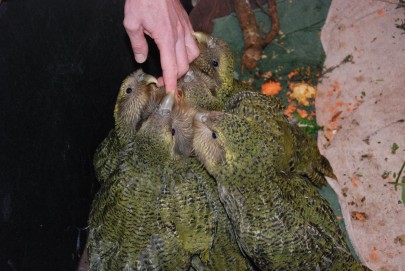Kākāpō, found only in Aotearoa New Zealand, are critically endangered, flightless, nocturnal, and the heaviest parrots in the world. Kākāpō quickly disappeared from most of NZ after the introduction of predatory mammals, and now comprise approximately 250 individuals on three small, predator-free islands. They also heavily depend on the production of rimu fruit to breed, which only happens every two to five years. This breeding cycle creates problems for kākāpō conservation, especially since rimu don’t occur in all of NZ’s forests. However, fossils show, that in the past, kākāpō were abundant and lived throughout New Zealand. The kākāpō niche must have therefore been much broader in the past than today.
A collaborative effort between scientists based at New Zealand (Manaaki Whenua – Landcare Research (MWLR), the University of Auckland New Zealand) and Australia (the University of Adelaide), used cutting-edge ancient DNA techniques and microscopic techniques, to investigate what plants kākāpō were eating in ancient New Zealand. They did this by looking at kākāpō coprolites (preserved droppings), which have been found in caves across the South Island. Radiocarbon dating also showed that these coprolites were typically hundreds of years old.

Kākāpō chicks being hand-reared at the Kākāpō Recovery Group's center at Invercargill. The chicks were born on Whenua Hou (Codfish Island), and several were moved to Invercargill, either to encourage the adult females to have a second clutch of eggs in the same breeding season, or to assist underfed chicks of inexperienced mothers. Image: Alex Boast
The new data has roughly doubled the number of plants known to be eaten by kākāpō and has revealed some striking revelations. For example, in one site, almost half of the coprolites contained pollen of the wood rose (Dactylanthus taylorii), a species that is now highly endangered, entirely parasitic on other plants, has no leaves, and was thought to be pollinated only by threatened short-tailed bats (Mystacina tuberculata). Additional evidence shows that kākāpō were frequently eating southern beech and beech mistletoes, results new to this study. Authors wonder whether these plants may have supported kākāpō breeding, as do rimu today.
Lead author Dr Alexander Boast, a palaeoecologist at MWLR, speaks of the relevance of this work. “Kākāpō are probably the only endangered species in the world that have such an extensive coprolite record. Since a lot of the food sources we identify aren’t recorded in modern diets, we have learnt a lot of new information about kākāpō. However, more generally, we also show how modern data can hugely underestimate our understanding of endangered species.”
“This work has come at a critical time for kākāpō conservation” says Dr Janet Wilmshurst, a palaeoecologist at MWLR, who has published extensively on conservation science in New Zealand using ancient materials. “The kākāpō population is increasing, and their islands can’t sustain them for much longer. Our work suggests that southern beech leaves and seeds were major kākāpō foods in the past, which is a big surprise since kākāpō hardly ever eat beech today. This means that beech forests are probably ideal habitats for kākāpō”.
“The observation with mistletoes is especially interesting” says Dr Jamie Wood, a lecturer at the University of Adelaide. “Parasitic plants like mistletoes are more nutritious than other plants, meaning they could have been valuable sources of food for kākāpō and other birds in some habitats. This is concerning because most New Zealand mistletoes are now in decline. We also show that kākāpō may be a lost pollinator for these threatened plants. Not just mistletoes, but also the parasitic wood rose, which we thought was only pollinated by bats”.
Professor George Perry at the University of Auckland says “When we look at endangered species, like kākāpō, we often come to this idea they are specialised to a narrow habitat range. For example, there is a common misconception that kākāpō can’t breed without rimu. However prehistoric evidence often shows that these species had much wider niches in the past. We should always use ancient data in conservation science when possible”.


